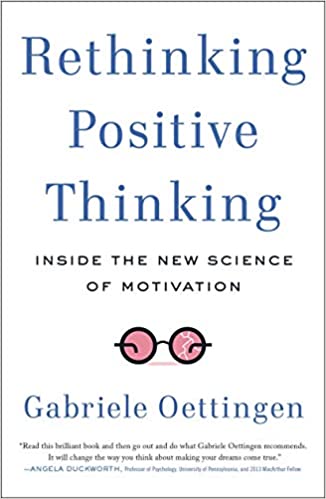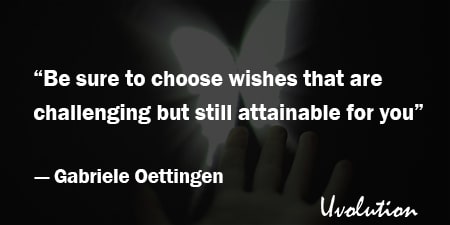Rethinking Positive Thinking by Gabriele Oettingen
The Book in 1 Sentences
Rethinking Positive Thinking: Inside the New Science of Motivation
“What is your dearest wish? What dreams do you have for the future? What do you want to be or do? Imagine your dream coming true. How wonderful would it be. How fulfilling.
What holds you back from realizing your wish? What is it in you that stops you from really going for it?
Rethinking Positive Thinking is a book about wishes and how to fulfill them. It draws on twenty years of research in the science of motivation. And it presents a single, surprising idea:
the obstacles that we think most impede us from realizing our deepest wishes can actually hasten their fulfillment.” ~ Gabriele Oettingen
6 BIG Ideas
Rethinking Positive Thinking Book Summary
“Rethinking Positive Thinking presents scientific research suggesting that starry-eyed dreaming isn’t all it’s cracked up to be. The book then examines and documents the power of
a deceptively simple task:
juxtaposing our dreams with the obstacles that prevent their attainment.”
1. Dreaming in not enough!
“If you want to unwind, you can take some deep breaths, get a massage, or go for a walk—but
you can also try simply closing your eyes and fantasizing about some future outcome that you
might enjoy.
But what about when your objective is to make your wish a reality? The last thing you want to be is relaxed. You want to be energized to get off the couch and lose those pounds or find that job or study for that test, and you want to be motivated enough to stay engaged even when the inevitable obstacles arise.
We’ve seen that the principle of ‘Dream it. Wish it. Do it.’ does not hold true, and now we know why: in dreaming it, you undercut the energy you need to do it. You put yourself in a temporary state of bliss, calmness—and lethargy.”
“More often than not, we are the exact opposite of electrified. It never ceases to impress me that we can measure a decline in energy and motivation almost instantly after a fantasy of wish fulfillment passes through a person’s mind.”
“By fooling our brains into thinking we’re already successful, we lose motivation and energy to do what it takes to actually become successful.”
“Based on two decades of research findings, replicated across a variety of research participants, contexts, and methods, you would be ill-advised to indulge in dreams about achieving your goals and then assume you’re well on your path to success. Life just doesn’t work that way.”
2. Mental contrasting
“Back in 1990, when my research was first beginning to show that positive fantasies were not helping people achieve their wishes, I was disappointed. I had embarked on studying dreams not merely because I found them interesting, but because I had hoped that dreaming might help people who were having trouble achieving wishes large and small.
It was difficult to focus my work on fantasies knowing that they made individuals continue to struggle, so I wondered if there was anything I could do to the process of dreaming to turn things around and make dreams more helpful for achieving wishes.
In particular, since positive fantasies tended to relax people, was there a way that I could use dreaming to wake them up, get them into gear, and motivate them to succeed?
I reasoned that the best way to get people up and moving was to ask them to dream and then to confront them right away with the realities that stood in the way of their dreams. I called this confrontation ‘mental contrasting.’
If I could ground fantasies in a reality through mental contrasting, I might be able to circumvent the calming effects of dreaming and mobilize dreams as a tool for prompting directed action.”
“Our study suggested that mental contrasting could help people do both things: engage even more forcefully when it made sense to engage, disengage even more forcefully when that made sense. It functioned as a self-regulation tool, helping people allocate their energy more efficiently so they didn’t merely pursue wishes, but wisely pursued them.”
3. Implementation intention .. ‘if-then’
“As time passed and Peter conducted more studies, he came to realize that forming a plan for how to attain a certain goal—what he termed the ‘implementation intention’—had a more powerful effect if it took on the particular form of an ‘if-then’ statement: ‘If situation x arises, then I will perform response y.’
Let’s suppose Jim feels inexplicably anxious when his regional manager stops by his office, so it’s difficult for Jim to start up a conversation or ask a question. Jim’s implementation intention might be ‘If I become nervous talking to my regional manager, then I will remind myself that I’m the top-performing salesperson in the district and my sales have increased since last year’;
or ‘If I become nervous talking to my regional manager, then I will excuse myself for a moment, take a few deep breaths to calm down, and return to the conversation.”
4. WOOP - Wish, Outcome, Obstacle, Plan
“As I started to teach mental contrasting with implementation intentions as a single, unified tool, I realized that we needed a better name than ‘MCII.’ The name WOOP—Wish, Outcome, Obstacle, Plan—came to us almost by accident in the course of fielding a study.
We liked how accessible WOOP was and how well it captured the key steps. As a tool, WOOP is what psychologists call ‘content neutral,’ that is, it can be used to help with any kind of wish you might have, short term or long term, big or small.
If you’re a professional, you can use it to reach a new milestone in your career, improve your skills—whatever you can think of. If you’re a student, you can apply it to study more productively. If you’re a mom or dad, you can apply it to handle challenging situations with your children more effectively.
Anyone can use it in his or her personal life for any purpose—for instance, to form closer relationships with others or improve health.”
“On a blank sheet of paper, name the wish in three to six words. Identify the best outcome (also in three to six words) and write it down. Now let your thoughts lead your pen, taking as much paper as you need.
Then name your obstacle and write it down. Imagine the obstacle, again letting your thoughts wander and lead your writing. To create a plan, first write down one specific action you can take to overcome the obstacle.
Write down the time and place where you believe the obstacle will arise. Then write down the if-then plan: ‘If obstacle x occurs (when and where), then I will perform behavior y.’ Repeat it once to yourself out loud.”
“If you want to take action toward a desired future, then be sure to choose wishes that are challenging but still attainable for you. WOOP won’t help you live more fully if your wish is to live on planet Neptune or become a billionaire within a year.”
“We would be wrong to jettison our dreams, just as we are wrong to blindly assume that simply dreaming something can make it so.”
5. WOOP daily
“Again and again, we’ve found that WOOP enables people to pursue their wishes more wisely, producing more desirable short- and long-term results than more traditional treatments or no intervention at all.
If you want a proven means of regulating your energies so that you move more effectively toward fulfilling your wishes, and if you want a method that is also safe, cheap, and easy to use, you should try WOOP.”
“WOOP is a living tool that you can use in your everyday life. Practiced daily over an extended period of time, WOOP enables you to not only solve specific problems or wishes, but live a life that is balanced, meaningful, and generally happy.”
6. 2 Questions!
“We are just beginning to rethink positive thinking, evolving the new science of motivation and mobilizing it to improve individuals’ lives and address social problems. But what we do know is very clear.
To make the most of our lives, we must face up to the role we play in hamstringing our own wishes. Doing so isn’t complicated, but it is profound and life changing.
With WOOP and mental contrasting, we motivate and empower ourselves to take action when it will really benefit us and those around us. We unleash powerful forces within us so that we can change habits of thought and behavior we’ve had for years.
It sounds like magic, and it feels like magic, but the science shows it’s real. Wishing you good luck on your journey of discovery, I’ll end with two vital questions that I hope you never stop asking yourself: What is your dearest wish? What holds you back from achieving it?”
Remember that “So many popular self-help programs and strategies aren’t scientifically validated. If you have something in your life that you’d really like to change—or even if you just want to enjoy it even more—you’d be well advised to dispense with the trendy ‘positive thinking’ approach and give WOOP a try.”
That was my QUICK summary of the great book Rethinking Positive Thinking by Gabriele Oettingen. If you’re interested, get your copy. There is a HUGE amount of life-changing ideas in this book, and we’ve only touched on a tiny bit of it.
Buy The Book: Rethinking Positive Thinking by Gabriele Oettingen

GET Blinkist 7 Days FREE Trial
3000+ Book Summaries
(Audio and Text)








